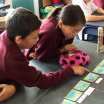Support participation and confidence
Support ākonga to be confident, active participants in the classroom and community.
On this page:
On this page:
Current page section: Support participation and confidence
Go to top of current page: Support participation and confidence
Go to top of current page: Support participation and confidence
Go to top of current page: Support participation and confidence
Design the day to maximise participation
Design the day to maximise participation
Discuss with students what will support their participation and motivation.
Build these suggestions into your teaching practice.
- Check in with the student regularly.
- Connect learning to the student’s interests.
- Establish clear classroom routines, expectations and rules.
- Provide task and lesson outlines.
- Break work into short manageable chunks.
- Schedule brain and movement breaks.
- Offer leadership opportunities and group roles based on the student’s expertise and interests.
- Foster tuakana-teina relationships where students support each other.
- Provide easy access to quiet spaces for working or winding down.
- Develop and teach strategies to help students when they get stuck.
- Notice task avoidance or increasing anxiety. Implement supports quickly.
Give students time
Give students time
Break work into manageable chunks.
Provide students with strategies to help them when they get stuck.
![5944 [MOE-Muritai-School-98.jpg]](https://inclusive-live-storagestack-assetstorages3bucket-3uty0hejzw6u.s3.ap-southeast-2.amazonaws.com/public/inclusive-education/example-images/MOE-Muritai-School-98__ScaleMaxWidthWzEwODZd.jpg)
Source: Ministry of Education | Te Tāhuhu o te Mātauranga
Respond to communication needs
Respond to communication needs
Ākonga will have unique communication needs. Work with them to understand their preferences and challenges. For example, some ākonga will enjoy speaking in large groups and others will not.
- Give ākonga time to think and talk.
- Listen without interruption.
- Provide ample opportunities for students to make their feelings, thoughts and needs known.
- Give students a heads up, when possible, so they can prepare their response.
- Model communication using the student’s means of communication, for example, using point to select, using the student’s communication device, or using NZSL.
Use chat stations
Use chat stations
Encourage participation by using a variety of approaches. In this video, Cult of Pedagogy’s Jennifer Gonzalez explains chat stations, a discussion strategy to get students more active and engaged.
Use a variety of discussion strategies
Use a variety of discussion strategies
Using a variety of strategies can make class discussions more equitable and ensure each student has an opportunity to contribute without the pressure of speaking to a large group.
The big list of class discussion strategies – Cult of Pedagogy
12 powerful discussion strategies to engage students – Reading and Writing Haven
- Think, Pair, Share – give students time individually, in pairs and then in the group.
- Framed discussions – share sentence starters or explicit frameworks to scaffold responses.
- Gallery walk or chat stations – students respond to prompts or questions placed around the room.
- Cafe style conversations – cafe style stations for ākonga to explore and share ideas and expertise. A “host” stays at each cafe table.
- Asynchronous techniques – for example use video response tools like Flip to record responses when students are ready.
- Backchannel chats – add discussion question sheets, voting options or digital platforms for students to use when they are ready to respond or as an alternative to speaking in class discussions.
Foster collaboration and group work
Foster collaboration and group work
Celebrate diversity by providing opportunities for ākonga to work with others using their strengths. Carefully design group or pair activities to suit learners and maximise productive interactions.
Use your understanding of social norms, diversity and masking to inform classroom design.
- Encourage tuakana-teina relationships and create a culture where students provide support for each other.
- Develop cross-cultural communication skills, learning about how conventions for conversation vary across cultures and contexts.
- Teach specific speaking and conversation skills. For example, rehearse ways to start and close a conversation, keep the conversation flowing, and use eye contact.
- Practise conversation skills where appropriate for the students, such as maintaining personal space between people, facial expressions and taking turns.
- Assign group roles such as speaker, listener, and note-taker to the group members.
- Provide strategies to help students to listen actively to each other, share ideas, and recognise different points of view. For example, use thinking tools such as De Bono’s thinking hats.
- Create social stories that break down a task or social situation into small and easy-to-understand steps, accompanied by descriptive pictures.
- Monitor the discussions to ensure that all students understand the task and have opportunities to participate.
Next steps
More suggestions for implementing the strategy “Helpful classroom strategies years 1-8”:
-
Current page Support participation and confidence
Return to the guide “Speech, Language and Communication”

Speech, Language and Communication
How to use this site
Guide to Index of the guide: Speech, Language and Communication
Strategies for action:
-
Identify needs and how to provide supportShow suggestions for Identify needs and how to provide support
-
Key areas to supportShow suggestions for Key areas to support
-
Helpful classroom strategies years 1-8Show suggestions for Helpful classroom strategies years 1-8
- Build language-rich environments
- Support participation and confidence
- Present information in different ways
- Support processing and planning
- Provide options to create, learn and share
-
Helpful classroom strategies years 9-13Show suggestions for Helpful classroom strategies years 9-13
